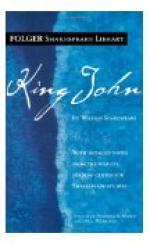|
This section contains 9,003 words (approx. 31 pages at 300 words per page) |

|
SOURCE: “‘He Is But a Bastard to the Time’: Status and Service in The Troublesome Raigne of John and Shakespeare's King John,” in ELH, Vol. 65, No. 4, Winter, 1998, pp. 779-98.
In the following essay, Gieskes compares the portrayal of the Bastard in King John and in The Troublesome Raign of John, King of England, highlighting Shakespeare's views on such social issues as class, rank, and vocation.
Introduction
Shakespeare's King John, standing between the two tetralogies, marks a transition in his treatment of political and historical questions. This argument has been advanced by critics like Sigurd Burckhardt, Virginia Vaughan, Michael Manheim, and Marsha Robinson (among many others).1 Vaughan, for example, writes that the play “demonstrates Shakespeare's experimentation with more sophisticated dramaturgical techniques to convey political complexities, techniques he perfected in the Henriad.”2 Most of the criticism focuses on Shakespeare's changing treatment of political questions to the exclusion of social considerations...
|
This section contains 9,003 words (approx. 31 pages at 300 words per page) |

|


